Anochetus traegaordhi Mayr
Listing as in Bolton (1995: 66)
  Type locality Sudan
(Anochetus traegaordhi nov.
spec., Mayr, 1904b: 2, single worker) Khartoum - no images on Antweb
(September 2014) Type locality Sudan
(Anochetus traegaordhi nov.
spec., Mayr, 1904b: 2, single worker) Khartoum - no images on Antweb
(September 2014)
junior synonyms
angusticornis
(Anochetus angusticornis n.
sp., Arnold, 1946: 56, worker & queen) from Zimbabwe - see
below
gracilicornis
(Anochetus gracilicornis
n.sp.,
Viehmeyer, 1923: 87, illustrated, worker; synonymy by Brown, 1978c:
559) from Sudan, Renk,
20.iv.1914
- see below
sudanicus
(Anochetus sudanicus, sp.
nov., Weber, 1942a: 47, illustrated, worker; junior synonym of gracilicornis by Brown, 1964d: 215;
synonymy by Brown, 1978c:
559) from South Sudan, east base of Mt Imatong
silvaticus
(Anochetus silvaticus n. sp.,
Bernard, 1952: 212, illustrated, worker & queen; synonymy by Brown,
1964d: 215) from Guinea,
Mt. Nimba collections - see below
worker and queen described (see Bolton, 1995)  . .
|
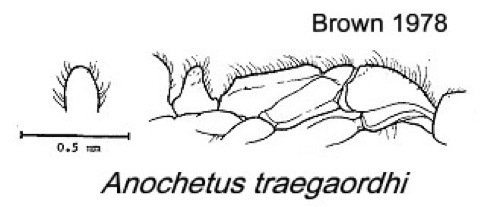 Mayr's
(1904b) description is at Mayr's
(1904b) description is at  . Viehmeyer's (1923)
description of gracilicornis,
with illustration of funiculus, is at . Viehmeyer's (1923)
description of gracilicornis,
with illustration of funiculus, is at  . Weber's (1942a)
description of sudanicus is at . Weber's (1942a)
description of sudanicus is at  . Arnold's (1946) description of angusticornis
is at . Arnold's (1946) description of angusticornis
is at  . Bernard's (1952)
description of silvaticus
is at . Bernard's (1952)
description of silvaticus
is at  . Brown's (1964d) note, is at . Brown's (1964d) note, is at  .
Brown's (1978) notes,
under the ghilianii complex, are at .
Brown's (1978) notes,
under the ghilianii complex, are at  . .
|
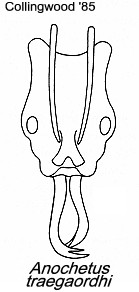 WORKER
- No more than a summary description was given by Brown (1978: 559,
illustrated), who places it in the very variable ghilianii
group. Main features as in key, especially the shortness of the frontal
striation on the head. A medium-sized species with medium-sized eyes
(0.20-0.35 mm). WORKER
- No more than a summary description was given by Brown (1978: 559,
illustrated), who places it in the very variable ghilianii
group. Main features as in key, especially the shortness of the frontal
striation on the head. A medium-sized species with medium-sized eyes
(0.20-0.35 mm).
Bernard (1952: 212), describing silvaticus,
gave - TL 5.3-6.4 mm; colour yellow-orange, slightly browner on the
mid-gaster. Integument with minute but very dense striations on the
anterior third of the head, the mandibles, and all the thorax, except
for areas on the sides of the pronotum and mesopleuron; rest of
mesopleuron and propodeum flanks matt. Petiole, gaster, tarsi and
posterior of head shiny, almost smooth save for reticulation on the
posterior angles of the head. Sparse white pubescence all over. Head
rather short, analogous to that of africanus in size, but less
indented, and with less prominent supraantennal lobes. Propodeum long,
matt, and very flat dorsally. Petiole scale conical, not indented on
the summit, yellow and shiny. Described related species as having the
sides of the thorax very smooth and the petiole scale bifid.
Collingwood (1985) noted - eye about 0.16 X HW,
mesonotum not striate, petiole tapering to a dorsal crest. The
specimens were from Saudi Arabia, foraging on the surface under bushy
scrub.
The illustrations given here suggest that the synonymy
of the pale and darker forms is
questionable but it is outside the scope of this website to comment
further.
In his first consideration, Brown (1964d: 215)
synonymised sudanicus (the
holotype) with gracilicornis,
noting a syntype of the latter was a little darker in colour. He
also synonymised silvaticus
(a cotype) with the type of A.
traegaordhi and a worker from Stanleyville, Congo, determied as traegaordhi by Forel.
Distribution of specimens recorded by Brown (1978c) was
sub-Saharan, south to Angola and Zimbabwe. From West Africa
there were three workers from Ghana, at CRIG, in a rotten log
(B. Bolton), notable as having relatively narrow heads (CI 84, eye
length 0.20 mm).
Brown (1978) did not report Bernard's (1952) records.
One
worker (as holotype of silvaticus) and one queen from Ivory
Coast; station H 5 (13.vii.1945, Delamare-Debouteville). One worker
from Guinea, station B 8.10, Zouépo, forest, 1215 m (Lamotte),
slightly larger and darker than Ivory Coast form.
|
In his key to European and African species, Brown (1978:
571, couplet 16) separated Anochetus
ghilianii (Morocco, S. Spain) from traegaordhi
(W. Africa, Sudan and Eritrea S to Angola and Rhodesia) by compound eye
size: ghilianii 0.18-0.22 in greatest diameter, tragaeordhi
0.20 mm in greatest diameter. No type images of either traegaordhi or ghilianii
on Antweb (September 2014). His commentary ([26], pp 598-600] is little
more than an admission of defeat in attempting to separate the various
forms and he simply lumped all sub-Saharan specimens under traegaordhi
because of "a bewildering range of variation in a number of traits,
including body size, eye size, gracility of antennae, abundance and
erectness of pilosity and pubescence, sculpture of vertex and pronotum,
and size and shape".
The ghilianii
cameroni, sylvaticus and Niakafiri-5-viii-09 have distinct
suberect pubescence on the mandibles.
Form
|
SI
|
EI (eye length/head
width, at eye level)
|
Notes
|
angusticornis (CASENT0902453)
|
100
|
25
|
yellow-brown;
propodeal corners angled and slightly raised |
SAM-HYM-C001378B
|
112
|
25
|
yellow-brown;
propodeal corners angled and slightly raised |
sudanicus (MCZ)
|
108
|
20
|
yellow-brown;
propodeal corners merely angled |
| gracilicornis (CASENT0915168) |
100
|
19
|
yellow-brown;
propodeal corners rounded
|
Niakafiri-5-viii-09
|
100
|
18
|
yellow-brown;
propodeal corners rounded |
silvaticus (CASENT0913742)
|
100
|
14
|
red-brown, quite
densely pubescent, notably so on the mandibles
|
Gabon-03
(CASENT0010781)
|
100
|
10
|
red-brown; raised
lateral corners on propodeum |
Cameroon FK sp1
|
111
|
11
|
red-brown; raised
lateral corners on propodeum
|
ghilianii cameroni (CASENT0907417,
CASENT0902459)
|
100
|
15
|
yellow-brown;
propodeal corners merely angled
|
|
Yellow-brown forms
|
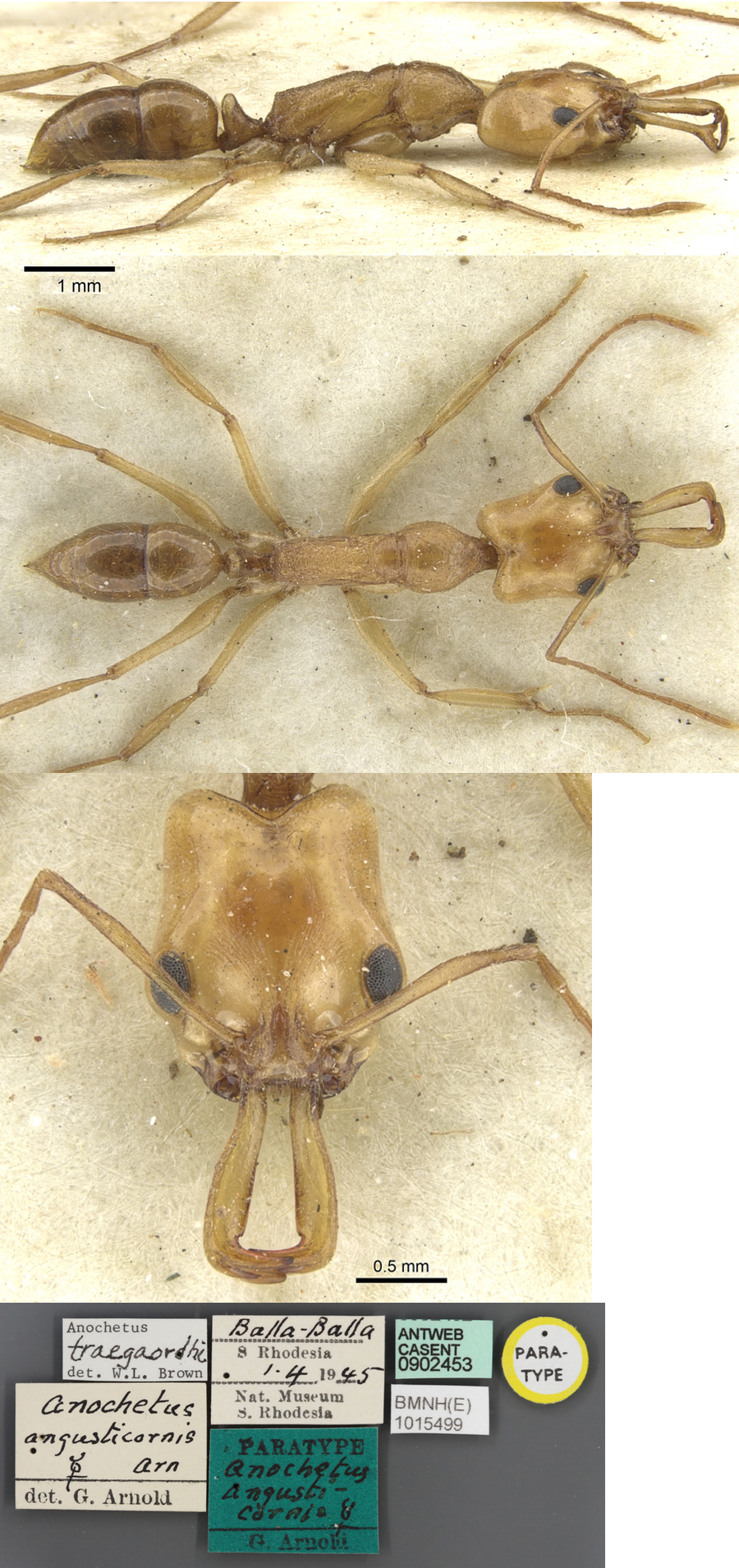 The
photomontage of an angusticornis
paratype is collated from http://www.antweb.org/specimen.do?name=casent0902453 The
photomontage of an angusticornis
paratype is collated from http://www.antweb.org/specimen.do?name=casent0902453
|
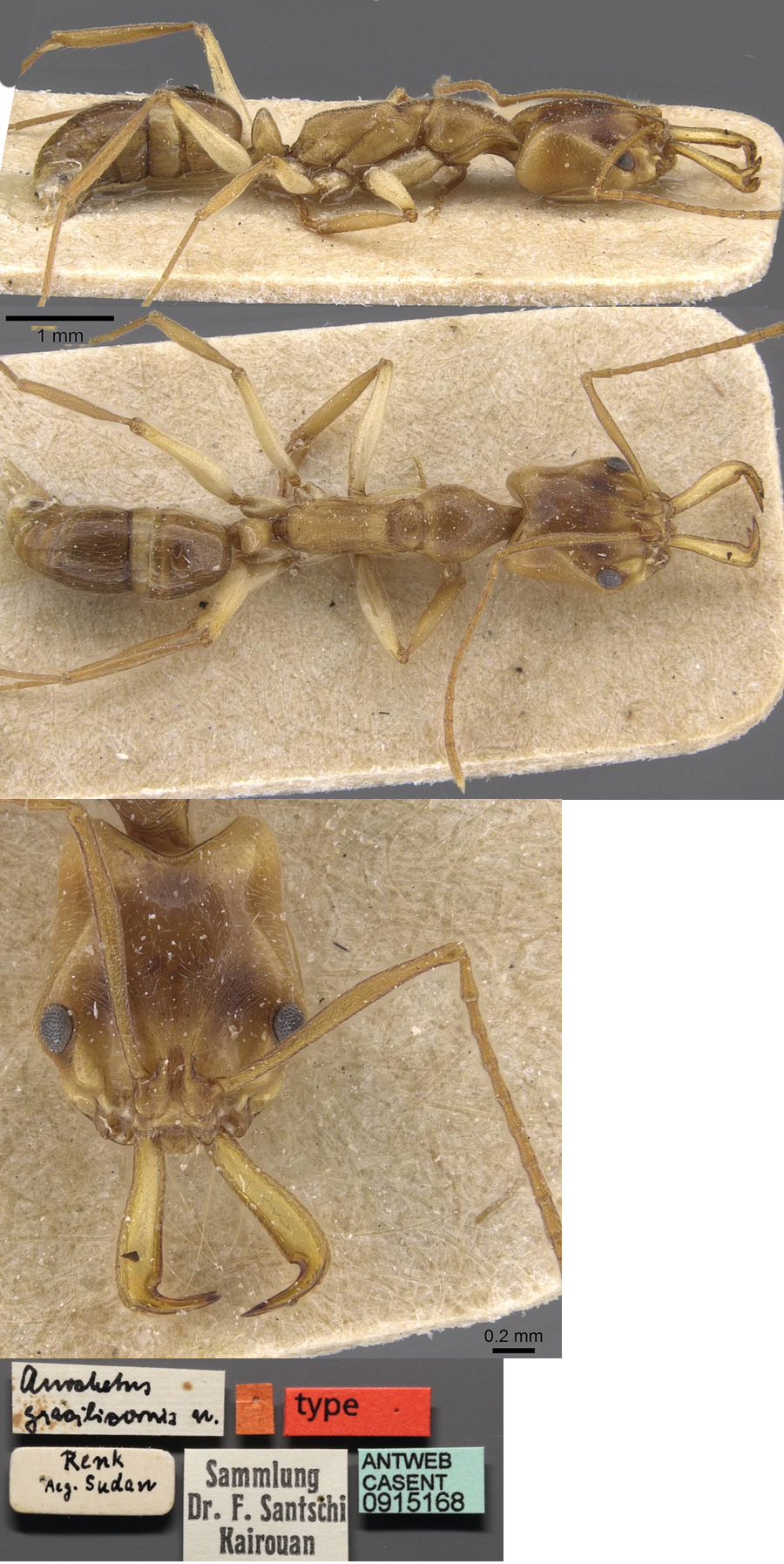 The
photomontage of a gracilicornis
type is collated from http://www.antweb.org/specimen.do?name=casent0915168 The
photomontage of a gracilicornis
type is collated from http://www.antweb.org/specimen.do?name=casent0915168
|

The
photomontage is of the holotype of Anochetus sudanicus Weber
(1942a). The original photographs, together with enlarged images, are
from the MCZ, Harvard University, website at http://mcz-28168.oeb.harvard.edu/mcz/FMPro?-DB=Image.fm&-Lay=web&-Format=images.htm&Species_ID=26107&-Find.
|
 The
photomontage is adapted from the Antweb.org site at http://www.antweb.org/specimen.do?name=SAM-HYM-C001378B
Collection Information: Locality South Africa: Natal: Mkuze Game
Reserve, below Mantuma; 27°36'00"S 032°13'00"E 60 m; Collection codes:
SAM-HYM-C001378; Date: 16 Oct 1998; Collected by: H.G. Robertson;
Method: saw nest/nest entrance Habitat: riverine, woodland The
photomontage is adapted from the Antweb.org site at http://www.antweb.org/specimen.do?name=SAM-HYM-C001378B
Collection Information: Locality South Africa: Natal: Mkuze Game
Reserve, below Mantuma; 27°36'00"S 032°13'00"E 60 m; Collection codes:
SAM-HYM-C001378; Date: 16 Oct 1998; Collected by: H.G. Robertson;
Method: saw nest/nest entrance Habitat: riverine, woodland
|
 The
photomontage is of a worker specimen collected from Senegal, Tambacounda; collector B
Ndiaye. The
photomontage is of a worker specimen collected from Senegal, Tambacounda; collector B
Ndiaye.
|
Red-brown forms
|
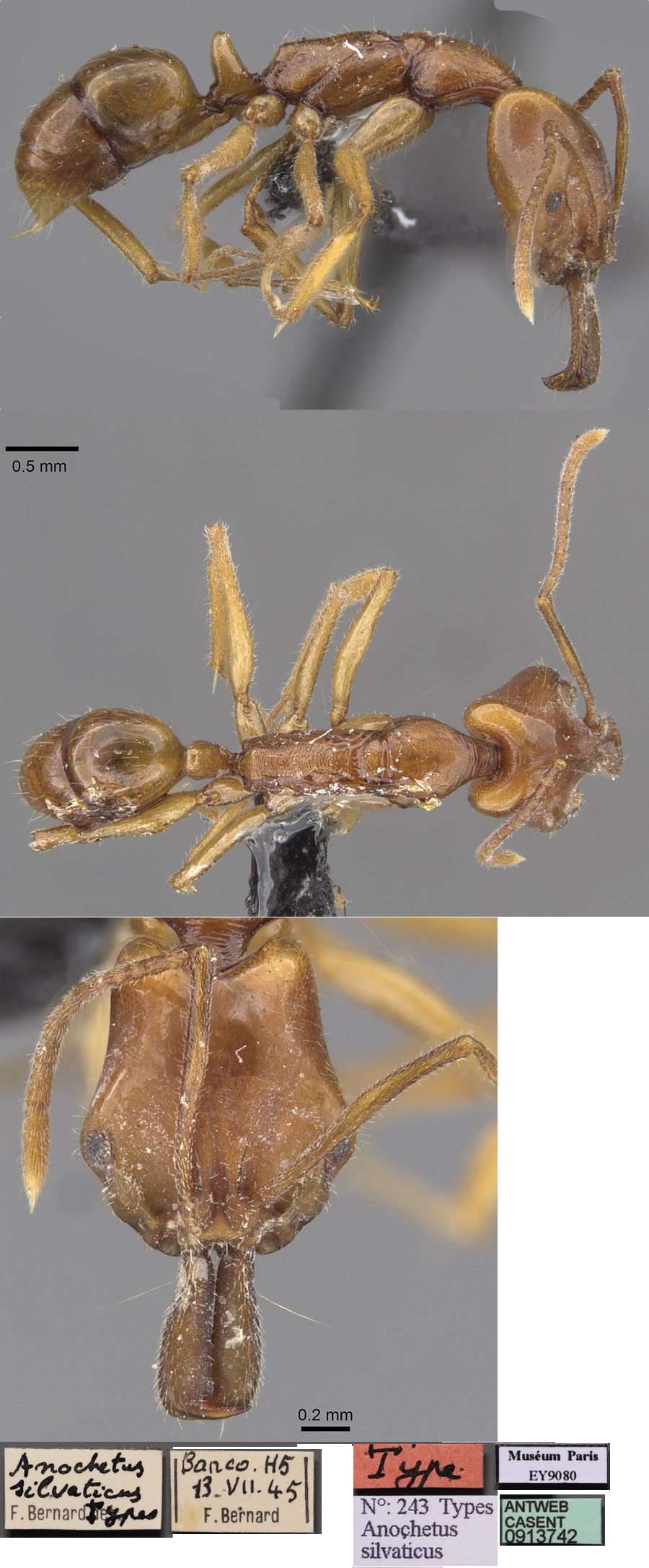 The
photomontage of the silvaticus
type is collated from http://www.antweb.org/specimen.do?name=casent0913742 The
photomontage of the silvaticus
type is collated from http://www.antweb.org/specimen.do?name=casent0913742
|
Oxford University Museum
specimens
Anochetus traegaordhi
B Taylor det.
|
Cameroun
A Fotso Kuate
Anochetus sp1
|
20.ix.2007
Awae II
03°54'30" N
11°25'58" E
|
Quadrat in forest
|
1
|
 |
|
 The
photomontage is of a worker specimen collected from Cameroun,
Awae; collector A Fotso Kuate (Anochetus sp1) The
photomontage is of a worker specimen collected from Cameroun,
Awae; collector A Fotso Kuate (Anochetus sp1)
|
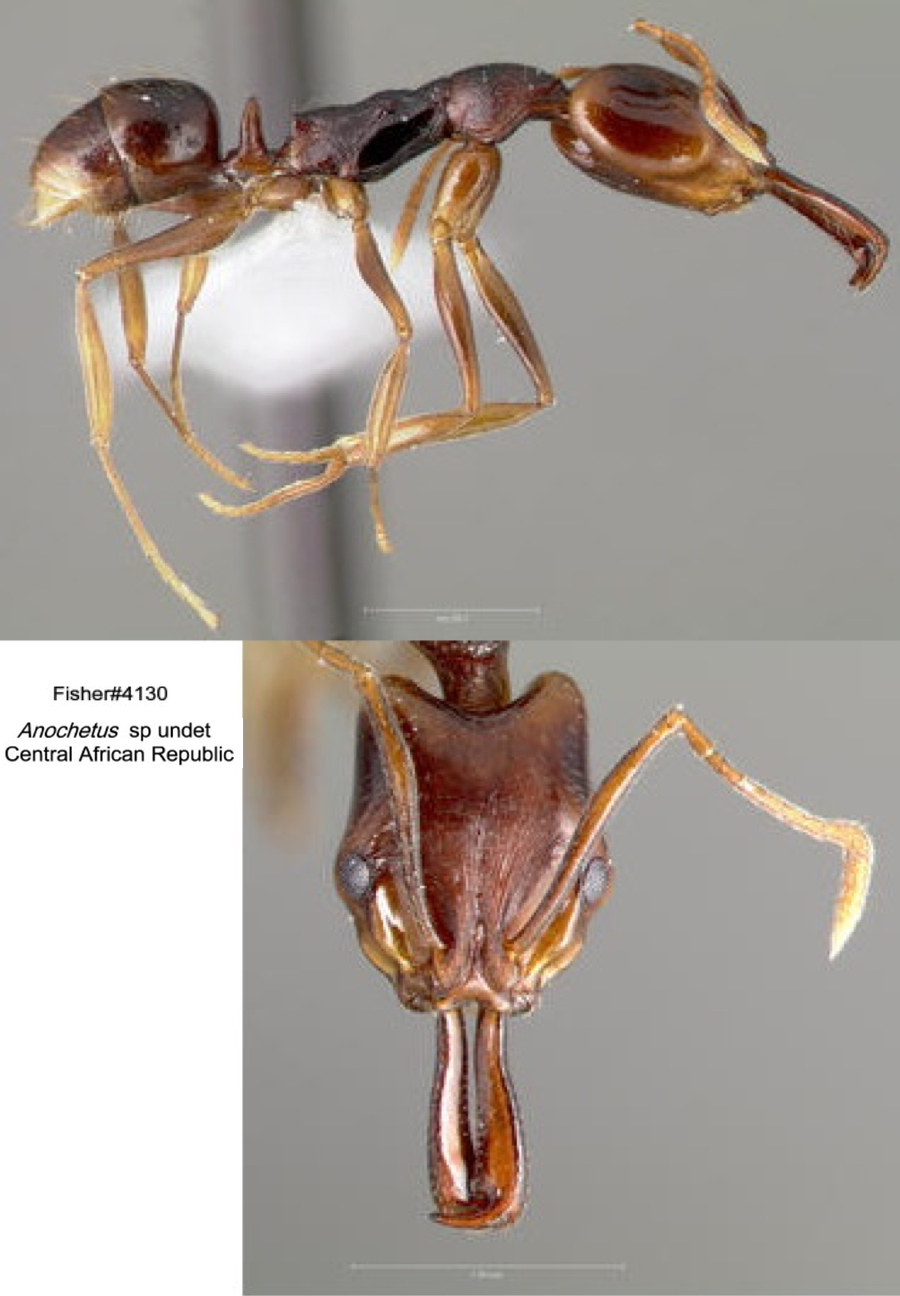 The
photomontage is collated from http://www.antweb.org/specimen.do?name=casent0408018 The
photomontage is collated from http://www.antweb.org/specimen.do?name=casent0408018
Collection details - Locality: Central African Republic:
Prefecture Sangha-Mbaéré; Parc National Dzanga-Ndoki, 37.9 km 169° S
Lidjombo; 02°22'14"N 016°10'21"E, 360m. Collection Information:
Collection codes: BLF4130. Date: 20-28 May 2001. Collected by:
B.L.Fisher. Method: EC19 sifted litter. Habitat: rainforest .Transect
Type: MW 50 sample transect, 5m Transect Sample No.: 08
|
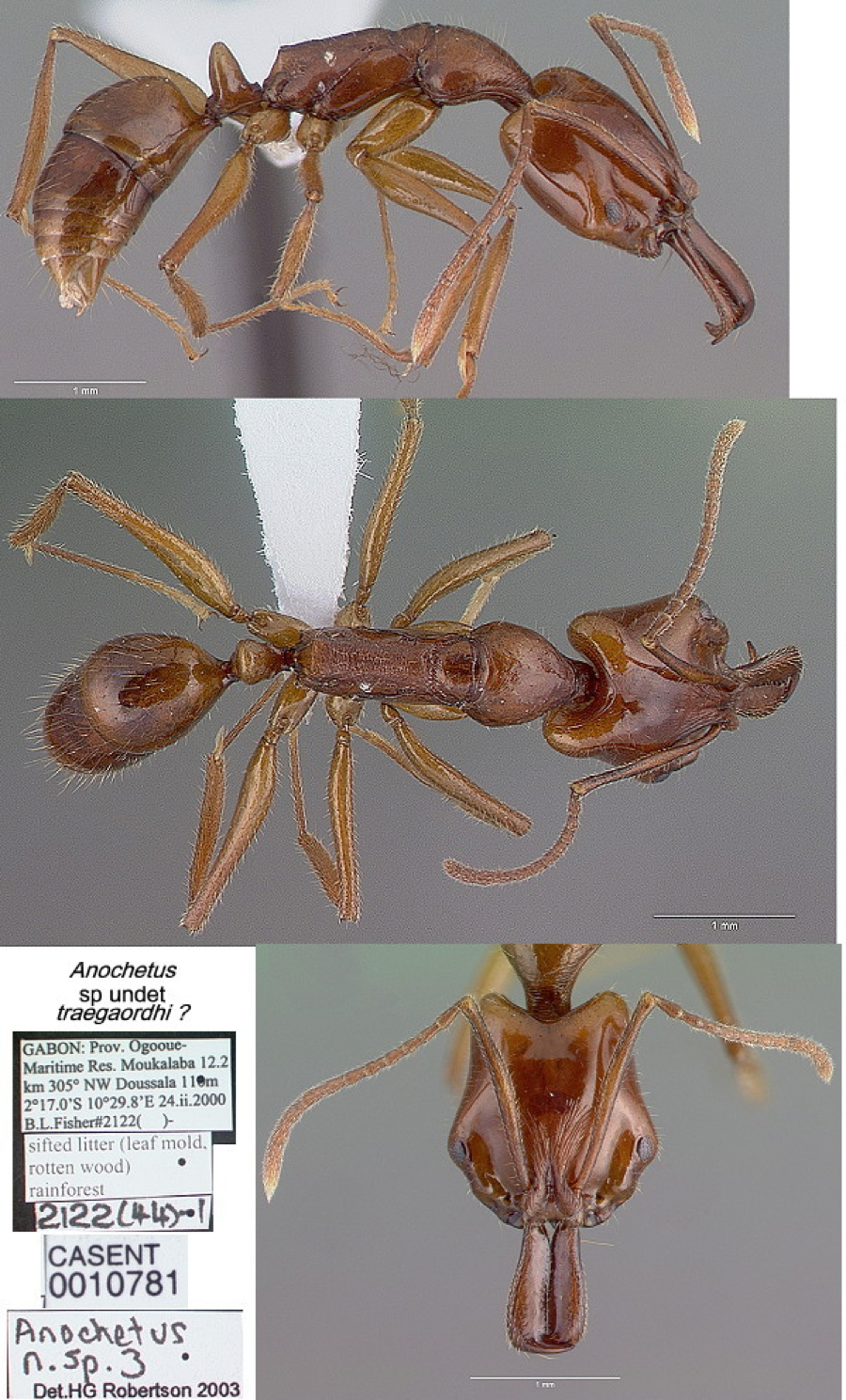 The
photomontage is adapted from the Antweb.org site at http://www.antweb.org/specimen.do?name=casent0010781
This specimen seems a better match to the original description by Mayr
(1904b) than the form drawn by Brown (1978). Collection Information:
Anochetus n. sp. gab-03 (Specimen Images): Specimen Code CASENT0010781:
Locality Gabon: Ogooue-Maritime: Reserve de Faune de la
Moukalaba-Dougoua, 12.2 km 305° NW Doussala; 02°19'00"S 010°32'00"E 110
m; Collection codes: BLF02122; Date: 24 Feb 2000; Collected by:
B.L.Fisher Method: EC19 sifted litter; Habitat: rainforest; Transect
Type: MW 50 sample transect, 5m; Transect Sample No.: 44 The
photomontage is adapted from the Antweb.org site at http://www.antweb.org/specimen.do?name=casent0010781
This specimen seems a better match to the original description by Mayr
(1904b) than the form drawn by Brown (1978). Collection Information:
Anochetus n. sp. gab-03 (Specimen Images): Specimen Code CASENT0010781:
Locality Gabon: Ogooue-Maritime: Reserve de Faune de la
Moukalaba-Dougoua, 12.2 km 305° NW Doussala; 02°19'00"S 010°32'00"E 110
m; Collection codes: BLF02122; Date: 24 Feb 2000; Collected by:
B.L.Fisher Method: EC19 sifted litter; Habitat: rainforest; Transect
Type: MW 50 sample transect, 5m; Transect Sample No.: 44
|
|